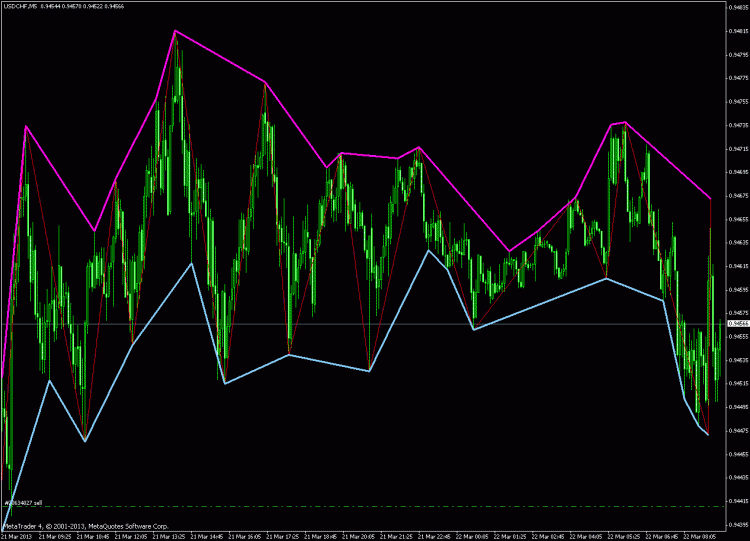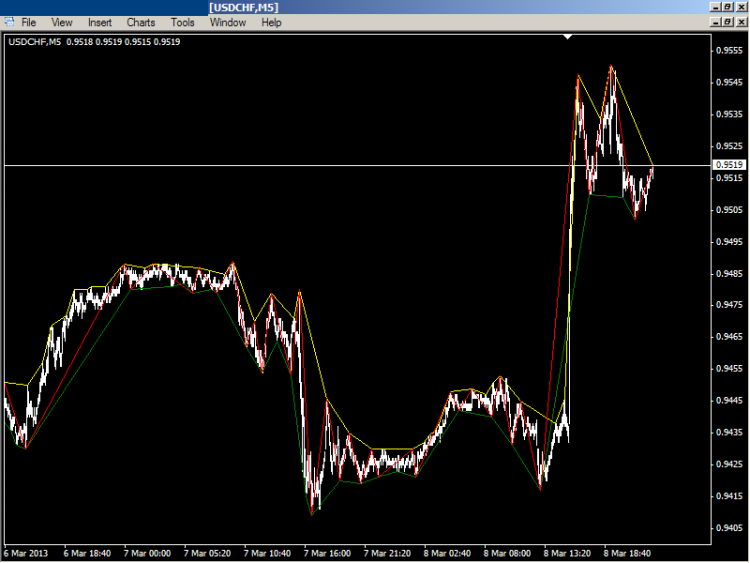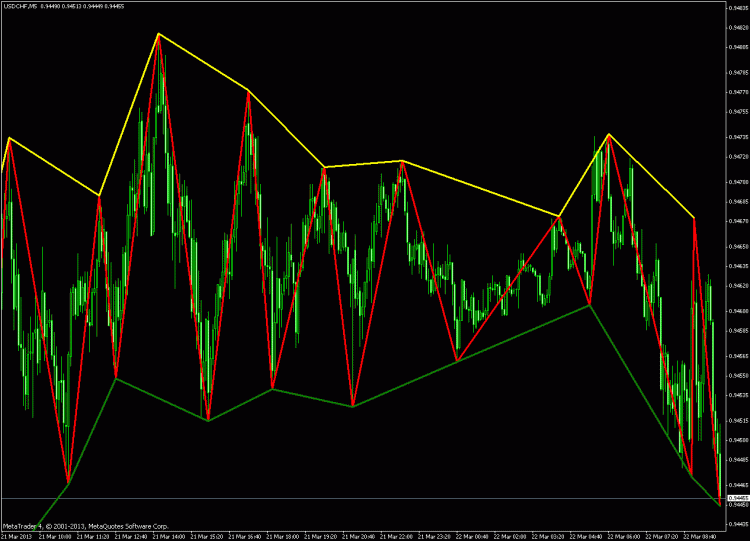けいよう
double K = iCustom(Symbol(),0,"zigzag",ExtDepth,ExtDeviation,ExtBackstep,0,i); if (K==Low[i] && K>0) //..low zigzag......
deVriesです。
iCustomの最後の2番目のパラメータを0に変更するということでしょうか?以前、この方法を試したことがあるのですが、結果は私が望んだものではありませんでした...私の質問を明確にするために、以下の2つの図を示します...
図1.ボトムだけを表示させたいのに、不要なトップが表示されています。ボトムだけを表示したいときに、不要なトップをすべてフィルタリングしたい。
図2.不要なボトムを表示せず、必要なトップスを表示する。これは私が望む結果です。
そこで質問ですが、ポイントA/B/C/D/Eを表示せずに、ボトムポイントだけを表示することは可能でしょうか?私は私が質問を明確にしたことを願っています....
迅速な回答をどうもありがとうございました....
//+------------------------------------------------------------------+ //| Zigzag2.mq4 | //| Copyright © 2005-2007, MetaQuotes Software Corp. | //| http://www.metaquotes.net/ | //+------------------------------------------------------------------+ #property copyright "Copyright © 2007, MetaQuotes Software Corp." #property link "http://www.metaquotes.net/" #property indicator_chart_window #property indicator_buffers 3 #property indicator_color1 Red #property indicator_color2 Magenta #property indicator_color3 LightSkyBlue //---- indicator parameters extern int ExtDepth=12; extern int ExtDeviation=5; extern int ExtBackstep=3; //---- indicator buffers double ZigzagBuffer[]; double HighMapBuffer[]; double LowMapBuffer[]; int level=3; // recounting's depth bool downloadhistory=false; //+------------------------------------------------------------------+ //| Custom indicator initialization function | //+------------------------------------------------------------------+ int init() { IndicatorBuffers(3); //---- drawing settings SetIndexStyle(0,DRAW_SECTION); SetIndexStyle(1,DRAW_SECTION); SetIndexStyle(2,DRAW_SECTION); //---- indicator buffers mapping SetIndexBuffer(0,ZigzagBuffer); SetIndexBuffer(1,HighMapBuffer); SetIndexBuffer(2,LowMapBuffer); SetIndexEmptyValue(0,0.0); SetIndexEmptyValue(1,0.0); SetIndexEmptyValue(2,0.0); //---- indicator short name IndicatorShortName("ZigZag("+ExtDepth+","+ExtDeviation+","+ExtBackstep+")"); //---- initialization done return(0); } //+------------------------------------------------------------------+ //| | //+------------------------------------------------------------------+ int start() { int i, counted_bars = IndicatorCounted(); int limit,counterZ,whatlookfor; int shift,back,lasthighpos,lastlowpos; double val,res; double curlow,curhigh,lasthigh,lastlow; if (counted_bars==0 && downloadhistory) // history was downloaded { ArrayInitialize(ZigzagBuffer,0.0); ArrayInitialize(HighMapBuffer,0.0); ArrayInitialize(LowMapBuffer,0.0); } if (counted_bars==0) { limit=Bars-ExtDepth; downloadhistory=true; } if (counted_bars>0) { while (counterZ<level && i<100) { res=ZigzagBuffer[i]; if (res!=0) counterZ++; i++; } i--; limit=i; if (LowMapBuffer[i]!=0) { curlow=LowMapBuffer[i]; whatlookfor=1; } else { curhigh=HighMapBuffer[i]; whatlookfor=-1; } for (i=limit-1;i>=0;i--) { ZigzagBuffer[i]=0.0; LowMapBuffer[i]=0.0; HighMapBuffer[i]=0.0; } } for(shift=limit; shift>=0; shift--) { val=Low[iLowest(NULL,0,MODE_LOW,ExtDepth,shift)]; if(val==lastlow) val=0.0; else { lastlow=val; if((Low[shift]-val)>(ExtDeviation*Point)) val=0.0; else { for(back=1; back<=ExtBackstep; back++) { res=LowMapBuffer[shift+back]; if((res!=0)&&(res>val)) LowMapBuffer[shift+back]=0.0; } } } if (Low[shift]==val) LowMapBuffer[shift]=val; else LowMapBuffer[shift]=0.0; //--- high val=High[iHighest(NULL,0,MODE_HIGH,ExtDepth,shift)]; if(val==lasthigh) val=0.0; else { lasthigh=val; if((val-High[shift])>(ExtDeviation*Point)) val=0.0; else { for(back=1; back<=ExtBackstep; back++) { res=HighMapBuffer[shift+back]; if((res!=0)&&(res<val)) HighMapBuffer[shift+back]=0.0; } } } if (High[shift]==val) HighMapBuffer[shift]=val; else HighMapBuffer[shift]=0.0; } // final cutting if (whatlookfor==0) { lastlow=0; lasthigh=0; } else { lastlow=curlow; lasthigh=curhigh; } for (shift=limit;shift>=0;shift--) { res=0.0; switch(whatlookfor) { case 0: // look for peak or lawn if (lastlow==0 && lasthigh==0) { if (HighMapBuffer[shift]!=0) { lasthigh=High[shift]; lasthighpos=shift; whatlookfor=-1; ZigzagBuffer[shift]=lasthigh; res=1; } if (LowMapBuffer[shift]!=0) { lastlow=Low[shift]; lastlowpos=shift; whatlookfor=1; ZigzagBuffer[shift]=lastlow; res=1; } } break; case 1: // look for peak if (LowMapBuffer[shift]!=0.0 && LowMapBuffer[shift]<lastlow && HighMapBuffer[shift]==0.0) { ZigzagBuffer[lastlowpos]=0.0; lastlowpos=shift; lastlow=LowMapBuffer[shift]; ZigzagBuffer[shift]=lastlow; res=1; } if (HighMapBuffer[shift]!=0.0 && LowMapBuffer[shift]==0.0) { lasthigh=HighMapBuffer[shift]; lasthighpos=shift; ZigzagBuffer[shift]=lasthigh; whatlookfor=-1; res=1; } break; case -1: // look for lawn if (HighMapBuffer[shift]!=0.0 && HighMapBuffer[shift]>lasthigh && LowMapBuffer[shift]==0.0) { ZigzagBuffer[lasthighpos]=0.0; lasthighpos=shift; lasthigh=HighMapBuffer[shift]; ZigzagBuffer[shift]=lasthigh; } if (LowMapBuffer[shift]!=0.0 && HighMapBuffer[shift]==0.0) { lastlow=LowMapBuffer[shift]; lastlowpos=shift; ZigzagBuffer[shift]=lastlow; whatlookfor=1; } break; default: return; } } return(0); } //+------------------------------------------------------------------+
ジグザグバッファーのみを表示することが可能でした。
ジグザグが再描画される
この結果を見る
以下はその結果です。私は上記のdeVriesの結果をチェックしていません(彼が投稿したときにこれをやっていました)。
#property indicator_chart_window #property indicator_buffers 2 #property indicator_color1 Green #property indicator_width1 1 #property indicator_color2 Yellow #property indicator_width2 1 double Bottoms[]; double Toppers[]; int init() { IndicatorBuffers(2); SetIndexStyle(0,DRAW_SECTION); SetIndexBuffer(0,Bottoms); SetIndexEmptyValue(0,0.0); SetIndexStyle(1,DRAW_SECTION); SetIndexBuffer(1,Toppers); SetIndexEmptyValue(1,0.0); IndicatorShortName("zz show top & bottom"); return(0); } int deinit() { return(0); } int start() { int counted_bars=IndicatorCounted(); int limit=0; limit = Bars-counted_bars; for(int shift=limit-1;shift>=0;shift--) { int ExtDepth=12; int ExtDeviation=5; int ExtBackstep=3; int ZigzagBuffer=0; int HighMapBuffer=1; int LowMapBuffer=2; Bottoms[shift]=iCustom( Symbol(),0,"ZigZag", ExtDepth, ExtDeviation, ExtBackstep, LowMapBuffer, shift ); Toppers[shift]=iCustom( Symbol(),0,"ZigZag", ExtDepth, ExtDeviation, ExtBackstep, HighMapBuffer, shift ); if(Bottoms[shift]>0.1) Bottoms[shift]=Bottoms[shift]; if(Toppers[shift]>0.1) Toppers[shift]=Toppers[shift]; } return(0); }
#property indicator_chart_window #property indicator_buffers 3 #property indicator_color1 Red #property indicator_width1 3 #property indicator_color2 Green #property indicator_width2 3 #property indicator_color3 Yellow #property indicator_width3 3 //---- indicator parameters extern int ExtDepth=12; extern int ExtDeviation=5; extern int ExtBackstep=3; double ZigZag[]; double Bottoms[]; double Toppers[]; int init() { IndicatorBuffers(3); SetIndexStyle(0,DRAW_SECTION); SetIndexBuffer(0,ZigZag); SetIndexEmptyValue(0,0.0); SetIndexStyle(1,DRAW_SECTION); SetIndexBuffer(1,Bottoms); SetIndexEmptyValue(1,0.0); SetIndexStyle(2,DRAW_SECTION); SetIndexBuffer(2,Toppers); SetIndexEmptyValue(2,0.0); IndicatorShortName("zz show top & bottom"); return(0); } int deinit() { return(0); } int start() { int counted_bars=IndicatorCounted(); int limit=0; limit = Bars-counted_bars; for(int shift=limit-1;shift>=0;shift--) { ZigZag[shift]=iCustom( Symbol(),0,"ZigZag", ExtDepth, ExtDeviation, ExtBackstep, 0, shift ); if(ZigZag[shift]>0.1 && Low[shift]==ZigZag[shift]) Bottoms[shift]=ZigZag[shift]; if(ZigZag[shift]>0.1 && High[shift]==ZigZag[shift]) Toppers[shift]=ZigZag[shift]; } return(0); }
これは、Resultとして与えています。
ボトムとトップがジグザグに一致するようになりました。
デブリーズ
あなたのコードの助けを借りて、私はこれに来たニースubzen....これは「結果」です。
ボトムとトップがジグザグに一致するようになりました。
こんにちは、deVriesです。
コードをありがとうございます。最後のジグザグ足のフィボナッチ・リトレースメントが、前のジグザグ足と比較してどの程度かを知りたいのですが、どうすればよいのでしょうか?どうすればいいのでしょうか?
写真のようにしたいのですが、下記のコードを試してもうまくいきません ...
ありがとうございます。
ジャック
#property indicator_chart_window #property indicator_buffers 3 #property indicator_color1 Red #property indicator_width1 3 #property indicator_color2 Green #property indicator_width2 3 #property indicator_color3 Yellow #property indicator_width3 3 //---- indicator parameters extern int ExtDepth=12; extern int ExtDeviation=5; extern int ExtBackstep=3; double ZigZag[]; double Bottoms[]; double Toppers[]; double resBuffer[][]; //--- int init() { IndicatorBuffers(3); SetIndexStyle(0,DRAW_SECTION); SetIndexBuffer(0,ZigZag); SetIndexEmptyValue(0,0.0); SetIndexStyle(1,DRAW_SECTION); SetIndexBuffer(1,Bottoms); SetIndexEmptyValue(1,0.0); SetIndexStyle(2,DRAW_SECTION); SetIndexBuffer(2,Toppers); SetIndexEmptyValue(2,0.0); IndicatorShortName("zz show top & bottom"); return(0); } int deinit() { ObjectDelete("myFibo"); return(0); } int start() { int counted_bars=IndicatorCounted(); int limit=0; limit = Bars-counted_bars; int k=0, m=0; int candle1=0, candle2=0; double prc1=0, prc2=0; for(int shift=limit-1;shift>=0;shift--) { ZigZag[shift]=iCustom( Symbol(),0,"ZigZag", ExtDepth, ExtDeviation, ExtBackstep, 0, shift ); if(ZigZag[shift]>0.1 && Low[shift]==ZigZag[shift]) { Bottoms[shift]=ZigZag[shift]; resBuffer[k][0] = Bottoms[shift]; resBuffer[k][1] = shift; k++; } if(ZigZag[shift]>0.1 && High[shift]==ZigZag[shift]) { Toppers[shift]=ZigZag[shift]; resBuffer[k][0] = Toppers[shift]; resBuffer[k][1] = shift; k++; } } // ende for //--- for(m=k;m>=0;m--) { candle1 = resBuffer[m][1]; prc1 = resBuffer[m][0]; candle2 = resBuffer[m-1][1]; prc2 = resBuffer[m-1][0]; //--- ObjectDelete("myFibo"); ObjectCreate("myFibo", OBJ_FIBO, 0, Time[candle1], prc2, Time[candle2], prc1); } // ende for return(0); }
deVriesさん、こんにちは。
コードをありがとうございました。最後のジグザグ足のフィボナッチ・リトレースメントが、前のジグザグ足と比較してどの程度かを知りたいのですが、どうすればよいでしょうか?どうすればいいのでしょうか?
ありがとうございます。
ジャック

このようにフィボナッチを描くと、ジグザグインジケーターiCustomで 2点を見つけることができます。
0.0 1.6154
100.0 1.6168
差0.0014
最後の高値= 1.6169
0.0との差 0.0015/0.0014 * 100% = 107% 距離 + 0.0001
ということなのでしょうか?
- 無料取引アプリ
- 8千を超えるシグナルをコピー
- 金融ニュースで金融マーケットを探索






皆様へ ジグザグのボトムのみを表示させるコードの修正方法について教えてください。